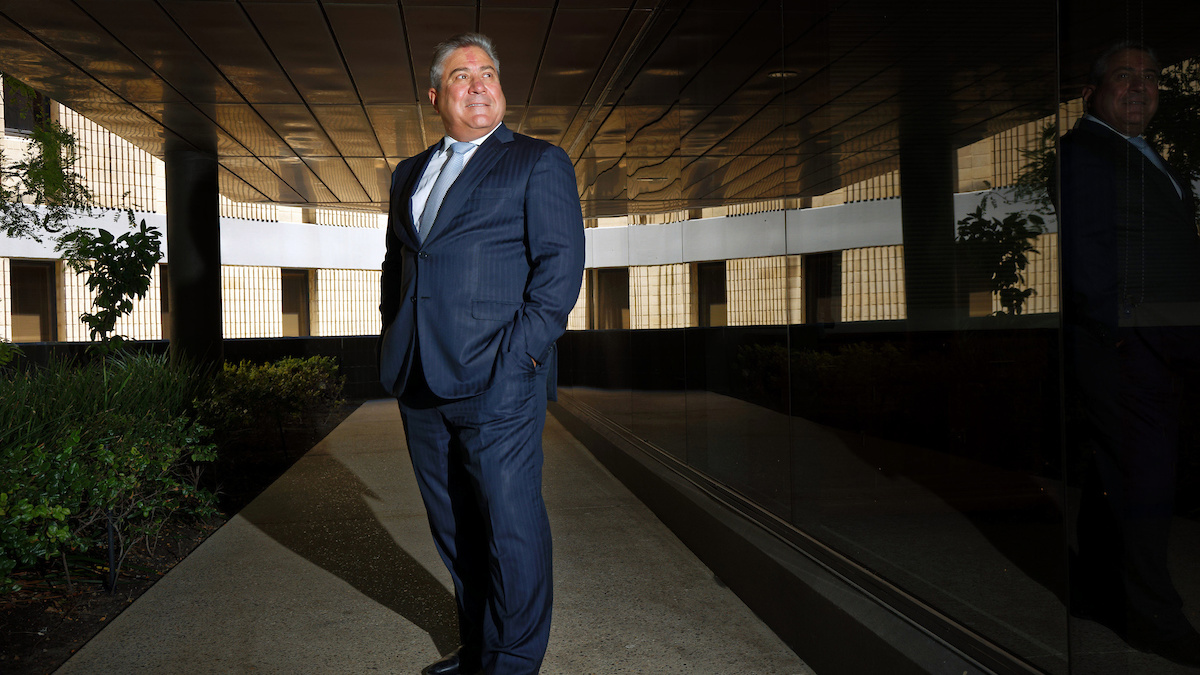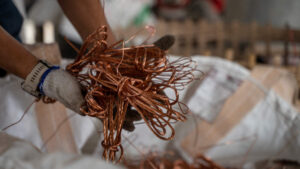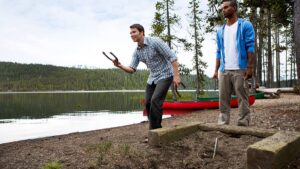Sandfire Resources boss Karl Simich talks about the copper miner’s transition from local legend to global player

Karl Simich's WA copper miner Sandfire is becoming a global player. Pic: Trevor Collens/Sandfire Resources
Sandfire Resources is set for its biggest change since the shock discovery of ultra-high grade copper at the DeGrussa prospect in May 2009.
That turned a 4c battler into one of the few major pure play copper miners on the ASX, worth $1 billion within just 18 months.
But as the DeGrussa mine winds up this year, Sandfire’s long time MD Karl Simich says it is poised for the next stage of its evolution.
He will fly out from the country this week despite the uncertainty posed by WA’s border arrangements to ink the most significant deal in the company’s history, a US$1.865 billion ($2.6 billion) splash on the MATSA copper complex in Spain.
Consisting of three existing underground mines around the province of Huelva — Aguas Teñidas, Magdalena and Sotiel — near the original Rio Tinto copper mine, Simich says the 100,000tpa copper and zinc project will make Sandfire a copper miner of global scale.
But it is just the beachhead. As copper emerges as one of the most critical commodities supporting the world’s transition from fossil fuels to renewable electricity, Simich says Sandfire aims to be a 300,000tpa producer by 2027-2030.
Sandfire Resources share price today:
The world needs copper
Sandfire came to copper mining via a happy accident of sorts — the DeGrussa discovery came in holes added onto a program drilling a shallow gold anomaly that turned out to be a halo for something much larger.
But Simich is confident it has put the $2.75 billion ASX-listed company in the right place to capture the key investment theme of the coming generation, the energy transition.
“The knock-on impact clearly, you know, whether it be in battery related minerals for lithium, for copper, for nickel, even the boom coming I hear for zinc, is that the fundamental demand for materials that are going to play a part of that, I’ve never seen such a strong sentiment running through the commentators are all collectively at the same time,” Simich told Stockhead.
“If we just talk about the copper space at the moment, and we see ourselves as moving from being a local, vibrant and lucrative but yet somewhat modest Australian domestic copper producer … to actually rolling on to the beginning of the world stage, let us say, and being relevant in that sense.”
With MATSA and the new Motheo mine in Botswana that Sandfire secured in its takeover of MOD Resources a couple years ago, due to open in 2023, it will be a 150,000tpa producer, with exploration and efficiency gains to potentially drive it beyond that level.
DeGrussa on its own is expected to generate around 64,000-68,000t of copper and 30-34,000oz of gold in FY22, meaning even with the closure of the high grade WA mine in September this year Sandfire’s corporate successes will double its production profile.
Copper has gone from US$2/lb at the start of the pandemic to US$4.40/lb (around US$9800/t) today, but Simich sees bright trading conditions for the commodity, with Goldman Sachs this month predicting it will rise to new records of US$12,000/t over the next 12 months and JP Morgan adjusting its 2022 and 2023 price forecasts up 10% and 17% respectively to US$4.20 and US$3.80/lb.
“I would dare say it hasn’t quite had the extraordinary volatility as let’s say iron ore during that period of time, and maybe lithium through that period of time, but it’s been a very solid movement from a fundamental price of US$3/lb (before the initial pandemic slump) to mid US$4/lb,” Simich said.
“So I think that’s really strong and even I saw recently coming out of London, Evy Hambro – who’s running Blackrock’s investments in natural resources, arguably the largest fund manager in the world – saying that he saw a long term persistent and consistent demand for EV related and primary commodities for the carbon neutrality.
“So I think there’s interesting momentum building at the moment. And if we are genuine about improving the state of the globe, then I think we’re going to see persistent demand.”
MATSA more than it says on the tin
The deal to buy Trafigura and Mubadala’s stakes in MATSA raised a few eyebrows.
Sandfire is understood to have pipped larger mining houses to secure the deal.
At US$1.30/lb it had the highest price to reserve ratio among 14 major copper mining and exploration deals assessed by JP Morgan last year, more than double the rate on that metric paid by South32 (ASX:S32) for its US$2 billion, 45% stake in the Sierra Gorda copper mine in Chile.
But Simich says looks can be deceiving. The price Sandfire paid for MATSA comes in at a similar price to NAV ratio as the Sierra Gorda deal and Evolution’s (ASX:EVN) purchase of the Ernest Henry copper-gold mine from Glencore.
He says Sandfire paid virtually nothing for the substantial exploration and development potential at MATSA, where the company expects to get the keys on January 31.
“The current owners over the last 15 years have spent, I think in the order of US$100 million in exploration,” he said.
“That translates to about US$6 million on average per year and that includes that infill mine drilling from getting resources into reserve categorisation. So in terms of true exploration, there has been very limited exploration expenditure.
“(Current owners) Trafigura are looking for production pipeline material, they’ve got a scale of the plant, the plant’s going to be filled for at least the next six to eight years from the reserves that are currently known, there is no point to one initially drilling out more resources into reserves.
“And they don’t need more exploration success, because they’ve already got reserves of six to eight years, they’ve already got resources that potentially takes that to 20 years. On top of that, they’ve got other mineral inventory that could take it even longer, more than 20 years.
“So from their point of view, they just say we’ve got enough of what we need at the moment but what we see is an exploration province — and we are explorers and miners, not traders — that has got significant exploration potential.
“And what we would be looking at doing also is utilising, and it hasn’t been done a lot there of recent times, high powered electromagnetics and a whole suite of other up to date state of the art exploration techniques, looking for a combination of higher grade primary copper mineralisation and closer to the operating facility.”
Simich said that could “turbocharge” returns in the early stages of its ownership by adding more reserves close to the mill and deliver new discoveries that could take MATSA’s life beyond 20 years.
He added that it will be at the bottom end of the cost curve.
“When you look at the quality of the profitability of the asset, the MATSA project delivers a much greater profit per pound of copper or per tonne of production. And I think where people get lost a little bit, sometimes in looking at comparatives, they selectively use comparatives that work for them,” Simich said.
“It’s about its profitability, its margin, because you could have a big mine that makes no money, or a small one that makes a lot of money. And I can tell you which one I’d prefer.
“MATSA is classified at a sort of 3% copper equivalent grade, in inverted commas a ‘high grade mine’.
“And so the margin for that project, it sits in the bottom 50% of the cost curve.”
More M&A on the cards?
Simich says Sandfire sees the potential to get to a 200,000tpa rate over time. One aspect will be the ramp up of MATSA, another will be the expansion of the Motheo complex in Botswana.
Sandfire paid $167 million in cash and shares for Motheo’s parent company MOD Resources in 2019.
A study on a base case 3.2Mtpa operation, costing US$259 million to build and producing 30,000t of copper and 1.2Moz of silver a year for 12.5 years, gave the mine a post-tax NPV of US$206 million.
That is now under construction, but studies to add the A4 pit to the T3 mine and increase its processing capacity from 3.2Mtpa to 5.2Mtpa are ongoing after a positive PFS last year, which increased its pre-tax NPV to US$672 million and IRR from 25% to 36%.
In the expansion case, annual copper production at Motheo would hit 60,000t at its peak, though its mine life would be slightly shorter.
Further down the line Sandfire is also conducting studies on the Black Butte operation in Montana, but has run into regulatory hurdles there.
Sandfire’s substantial land holding in the underexplored Kalahari copper belt around Motheo and its incoming MATSA complex provide opportunities for growth through exploration, but as Simich knows first hand with Sandfire’s inability to make a new major discovery at its DeGrussa mine over the past decade, it cannot rely on drilling alone.
The company has aspirations to become a 300,000tpa miner by the end of the decade. That would no doubt make it a global mining name, but would almost certainly require more M&A.
While the focus in the coming months will be on bedding down MATSA, a project Simich has coveted for four years, he has not shut the door to further deals as long as they clear Sandfire’s bar of entry.
“The thing about exploration success, as we’ve come to understand and realise, we can wish and hope and pray but we can’t invent it,” he said.
“So as much as we might be desirous of it, and we might be putting a lot of effort into it and spending money, we can’t bank on it. So to some extent, that means the door for inorganic growth, acquisitions will very much be open, alive and vibrant.”
Whither DeGrussa?
M&A could help keep Sandfire’s operations in WA ticking along as well, barring a Hail Mary success at DeGrussa.
DeGrussa has set Sandfire up on a growth platform since opening a decade ago, generating billions of dollars in revenue since its chance discovery.
“I was looking at a piece of paper the other day that just got found in the archives,” Simich said.
“And it was after the second drill hole, I wrote on a piece of paper and I said, it’s about 2 or 3 million tonnes at 15% copper, it’s going to cost us this much and the company will be worth about $1.3 billion, and the share price will be about eight bucks a share.
“And I did that on a little Excel spreadsheet about so big. And that was in May of 2009. And it’s pretty much got the tons and the grade sort of wrong, but sort of right.
“And the end result was … it sort of, I had $8.16, or something as a number, and that was after the first or second drill hole. So I’m going to frame it actually and put it on the wall and say, ‘Oh God, remember those days?'”
The lack of discovery since has been a major headache for Sandfire.
“We are embarking at the moment on a program of some deeper targeting to make sure that you know, it’s not just a little bit below where we’ve generally had a look. We’ve looked down quite intensely to 200-300m,” Simich said.
“What I can say is that if you were to find similar types of grade ore bodies, 4%, 6%, 9% that we’ve had with DeGrussa and Monty, they are well and truly imminently payable and make a lot of money at a depth that’s not very far at all.
“I would say also we have spent a bit of money, I think there is also the opportunity for the Hail Mary, but like anything we’re not banking on it.”
Instead Sandfire is looking at the prospect of retooling the DeGrussa plant to process gold from the Old Highway deposit nearby.
At a maiden resource of 2.8Mt at 2.5g/t for 223,000oz, it is relatively modest, meaning Sandfire is looking outside its walls to find the scale to develop the asset.
That could mean a JV with other regional gold miners or owners of stranded assets or the formation of a new gold company within or outside of Sandfire.
Some of the major players in the region include Westgold Resources (ASX:WGX) and TSX-listed Superior Gold, which owns the Plutonic Gold mine near Meekatharra.
“In terms of DeGrussa we still see an opportunity there to creating value out of those facilities,” Simich said.
“We have got a $400 million facility that is in excellent working condition that has been well looked after, well maintained.
“It’s never wanted for an end, it’s a high quality set of infrastructure.
“We are doing work on our greater Doolgunna gold analysis, some feasibility work, resources, some planning, and getting it tied up so we’ve got a lot of information that we then can utilise and talk to third parties about maybe collaborating together to do something that might work for those operations.
“At the same time, (we can) continue to explore for repeat VMS discoveries and the Hail Mary.”
Related Topics

UNLOCK INSIGHTS
Discover the untold stories of emerging ASX stocks.
Daily news and expert analysis, it's free to subscribe.
By proceeding, you confirm you understand that we handle personal information in accordance with our Privacy Policy.








